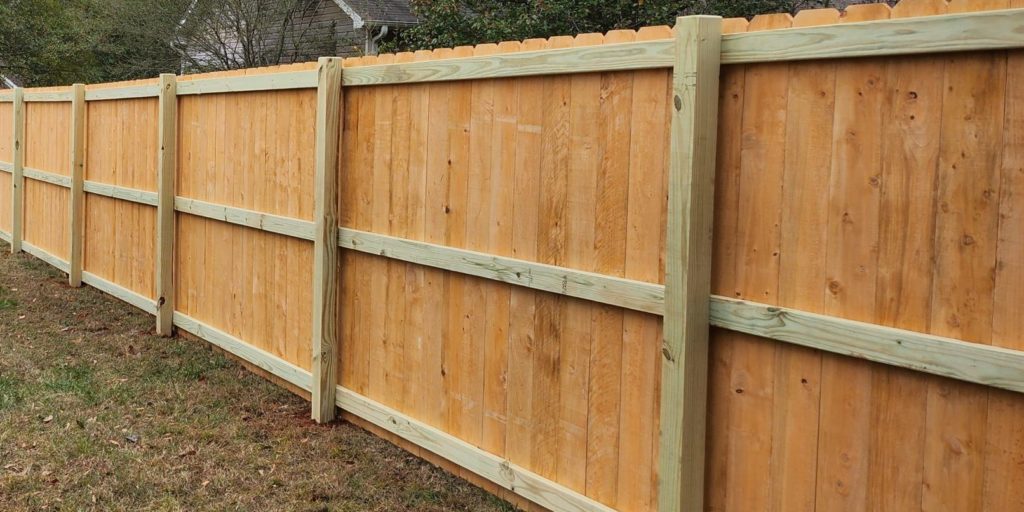The Supreme Difference
Quality Materials, Expert Installation. Supreme Fence goes the extra mile to make sure your wood fence lasts as long as possible. Here are some things that come standard with our installs, that you may not get from other contractors:
Schedule A Measuring With Our Fence Experts

#1 Grade Wood Fence-
- #1 grade, Ground Contact Pressure Treated Framing Lumber (compared to #2, standard treatment)
- #1 grade lumber has tighter grains, and smaller/fewer knots than #2 or #2 prime. Don’t be fooled: #2 Prime is an appearance grade board, and is much lighter and less sturdy than a #1 grade board.
- Ground contact provides better weather resistance than standard treatment. Most posts on the market are ground contact rated, but we take it a step further with ground contact grade 2×4 rails.
- Premium 3/4″ Thick Fence Pickets (compared to the standard 5/8″ thick)
- Thicker pickets means less warping, splitting, and checking, and are more rigid than 5/8″ pickets
- Premium pickets have less knots and barked edges than standard pickets
Expert Installation
- Short, even spaced sections (image)
- All sections are 7′ 6″ or less, shorter sections means more strength
- All sections on a side are evenly spaced (instead of one short section at the end)
- Overlapped seams (image)
- When possible, we use longer 2×4 frame rails that secure 2 sections together, then offset the joints so your whole fence is tied together as one unit. This provides better strength, and resists post warping.
- Solid Post Installation (image)
- All line posts are set in a 8″x 24″ deep hole with 50 lbs. of concrete
- All single gate posts are set in a 12″x24″ deep hole with 100 lbs. of concrete
- All posts are set with fast-setting concrete, and allowed to cure fully before the frame is built.
- Durable Gates (image)
- All gates are built onsite, specifically for your application
- If possible, gates are centered for a symmetrical look
- Heavy duty hardware, solid frame construction, and posts set deep means your gate will last for a long time
- Calculated Spacing (image)
- Frame rails are spaced as much as possible (vertically) to avoid the tops of the pickets warping, and to provide a solid barrier at the bottom of the fence for escape artists. We aim for about 3″ of picket above the top rail, and 3″ below the bottom rail.
- Pickets are installed about 1″ off the ground, to allow drainage. If you are worried about the gap at the bottom, ask us about adding a Rot Board
We Go the Extra Mile
- HOA diagrams and descriptions available for your convenience
- Customizable build plans suited for your needs
- All material is delivered in a timely manner, close to the start date. No piles of lumber killing your grass for 2 weeks
- No mess left behind, ever.
General FAQ's
What qualifications do you have to build fences?
We are licensed, insured, and bonded. Our Carpentry Contractor’s license qualifies us to build decks, pergolas, and to install framing for houses. No trade license is required to build fences, but we’re definitely qualified to build the best fences possible. We of course hold business licenses for any cities we perform work..
Do you install any custom fences?
Yes! We love trying new things. Whether your HOA requires an arched style top, or you just saw a picture online of a fence you like, we can make it happen. We also do farm and ranch style fences.
I like my quote and want to move forward. What now?
Good to hear! We’ll send over a contract outlining the project, and an invoice for a deposit. (50% deposit, 50% upon completion). The contract will outline price, materials, style, timeline, and more.
What do I need to do before installation?
We highly recommend having a property survey done before a fence installation. We will stake out the placement of the fence before we break ground, to be approved by you. If you have private utilities (irrigation, power to a shed), we need to know. All public utilities will be marked by 811 (called in by us) before we break ground. Also, if you have any plants or objects in the work area that are sensitive, they need to be moved, or we need to be notified so we can take precautions. If your neighborhood has an HOA, we can help with the documents needed for approval.
